Sustainability
Health Management
Health Management
Nitta Group’s Value Creation Story and Health Management
In the Nitta Group, one of the concrete ways in which we aim to create value is by establishing an attractive and rewarding workplace environment. Focusing on health and productivity management* is a key to achieving this aim.
Through health management, the goal is to enable each group employee to unleash their potential and become a “shift innovator with a focus on manufacturing”, as set forth in our medium-term management plan.
*Health and Productivity Management is a registered trademark of the NPO Kenko Keiei Kenkyukai
Health Management Declaration
The Nitta Group has formulated the Nitta Health Management Declaration to promote health management.
Health Management Declaration
We believe that the mental and physical health of each and every employee, being motivated and empowered to function to the best of their ability, is essential to the realization of Nitta’s mission. We therefore treat employee wellbeing as a core management priority.
In order to carry on and continue building upon Nitta’s more than 130 years of history and tradition, we will work together to promote individual health as foundational to our operations.
Going ahead with you
Seiichi Kitamura
President & Representative Director
Nitta Corporation
(Enacted date: June 8, 2018)
Health Management Strategies and Final Outcome Measures
To create an attractive workplace environment where each employee can thrive, we will advance health management based on the three key concepts of a healthy body, a healthy mind, and a healthy workplace.
Nitta Initiatives: Invigorating the Body, Mind, and Workplace
- 1. Healthy bodiesTo promote robust physical health, we support employees in improving their lifestyle habits with respect to diet, exercise, sleep, smoking, alcohol consumption, and so on. This reduces the risk of future cancer and lifestyle-related diseases, while preventing mental and physical discomfort and reducing medical expenses in both their work and private life.
- 2. Healthy mindsWe conduct stress checks, offer mental health education, and provide information to protect healthy minds.
We seek to support mental wellbeing by working to prevent mental health issues. The goal is to prevent loss of productivity and absence from work. - 3. Healthy workplacesIn conjunction with work style reforms, we will seek to optimize working hours, expand work and leave options, and otherwise make efforts to create comfortable workplaces. We will achieve an attractive work environment by enhancing company satisfaction and leisure time through improved work-life balance, and by aiming for a lively workplace.
Therefore, we have set the following three indicators as the final performance indicators of health management.
- Outcome Indicator 1. Reduction in Prevalence of Metabolic Syndrome (Lowering Lipid Risk)
By reducing the rate of metabolic syndrome and the associated lipid risk, we aim to improve physical health.
Specifically, we will work on improving dietary habits, exercise routines, and smoking habits*. By raising awareness of disease prevention, we aim to bring about a change in employees’ behavior. * Smoking is a factor that increases lipid risk by reducing HDL cholesterol and increasing LDL cholesterol. - Outcome Indicator 2. Reduction in presenteeism*. Through a healthy body, mind, and workplace, we aim to reduce presenteeism. To achieve this, we will focus on improving employees’ sleep habits—which are closely related to presenteeism—and increasing their job satisfaction. We will also work to reduce levels of stress among employees who are identified as being highly stressed. *Presenteeism refers to the state in which employees attend work but are unable to perform at their full capacity due to health issues.
- Outcome Indicator 3. Improvement in Work Engagement. By improving work engagement, we aim to create a healthy workplace. Specifically, we will focus on enhancing job satisfaction and leisure time, both of which have a significant impact on employees’ work engagement. To improve their work-life balance, we will encourage more employees to use their paid vacation.
To achieve the indicated outcomes, we have clarified and illustrated the connections between individual measures and outcome indicators in a Health Management Strategy Map. Refer to the following link for more information.
Promotion Structure
Various policies are implemented at Nitta, which are led by the Health Management Promotion Project team and under the guidance of the president as the chief health officer. Management executives also participate in carrying out these policies. The project team provides reports on initiatives and best practices to the Sustainability Committee as appropriate. In addition, an in-house newsletter fosters awareness among employees.
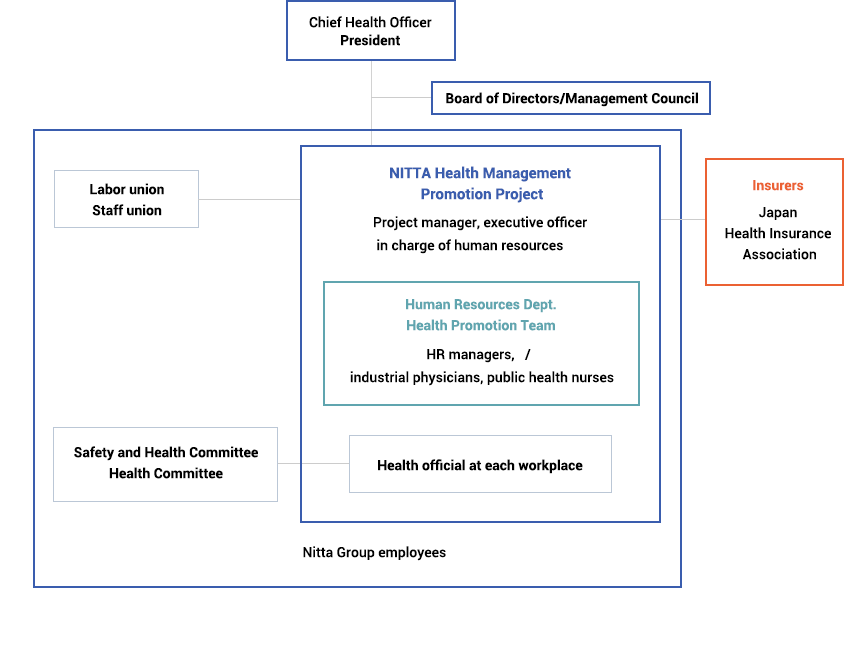
Achievements and Future Initiatives of Health Management
Regarding a Healthy Body
At the time of formulating our Health Management Declaration in 2018, our company’s prevalence rate of metabolic syndrome (known as ‘metabo’ in Japan) was about 3% higher than the national average as stated by the Japan Health Insurance Association. Metabo is closely associated with lifestyle-related diseases such as hypertension. To promote robust physical health in our employees, we set a target for reducing the metabo prevalence rate by 2.7% and the lipid risk prevalence rate by 2.5% for the fiscal year 2021. We continue to participate in the Japan Health Insurance Association’s Workplace Health Declaration each year.
When we issued the Health Management Declaration, the rate of metabolic syndrome among Nitta employees was roughly 3% higher than the national average.
By the end of the fiscal year 2021, we achieved a reduction of 3.2% in the lipid risk prevalence rate, surpassing our target. Meanwhile, the prevalence rate for metabo fell by 2.0%, not quite meeting our goal.
To further reduce the rate of metabolic syndrome, our employees need to adjust their lifestyles. By the fiscal year 2025, we aim to have 85% of people be interested in improving their lifestyle, a 50% rate of good walking habits, and a 70% rate of proper dietary habits. We are committed to working with our employees to improve their lifestyles.
While continuing to participate in the Workplace Health Declaration, we aim to increase awareness of daily lifestyle habits through activities such as walking events and by offering healthy meal options in the company cafeteria. We intend to improve lifestyle habits, leading to a reduction in the rate of individuals with metabo.
Effect of Participating in the Workplace Health Declaration
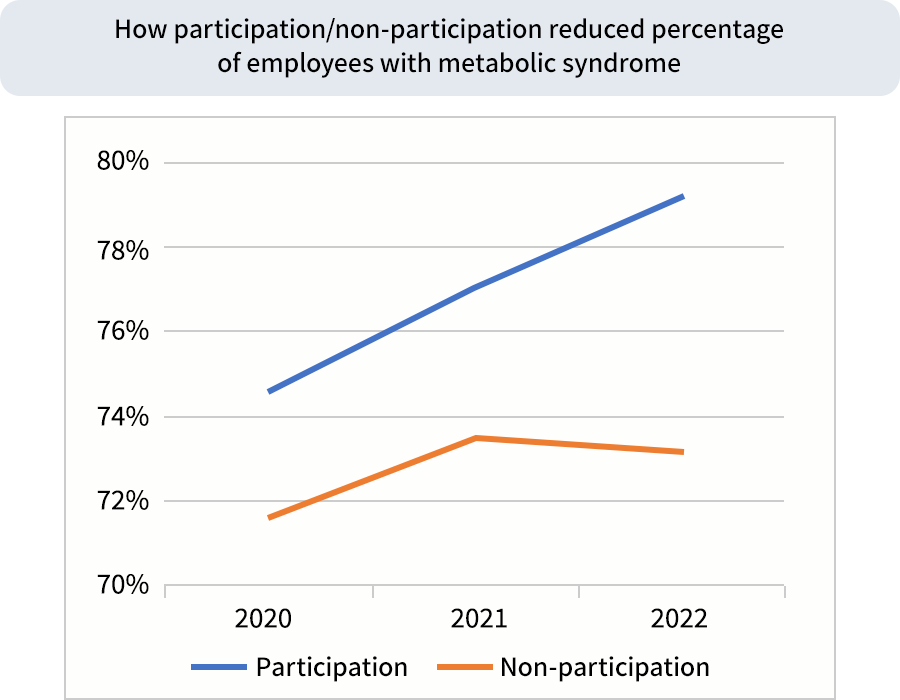
Nara Branch of the Japan Health Insurance Association
Poster for the Workplace Health Declaration
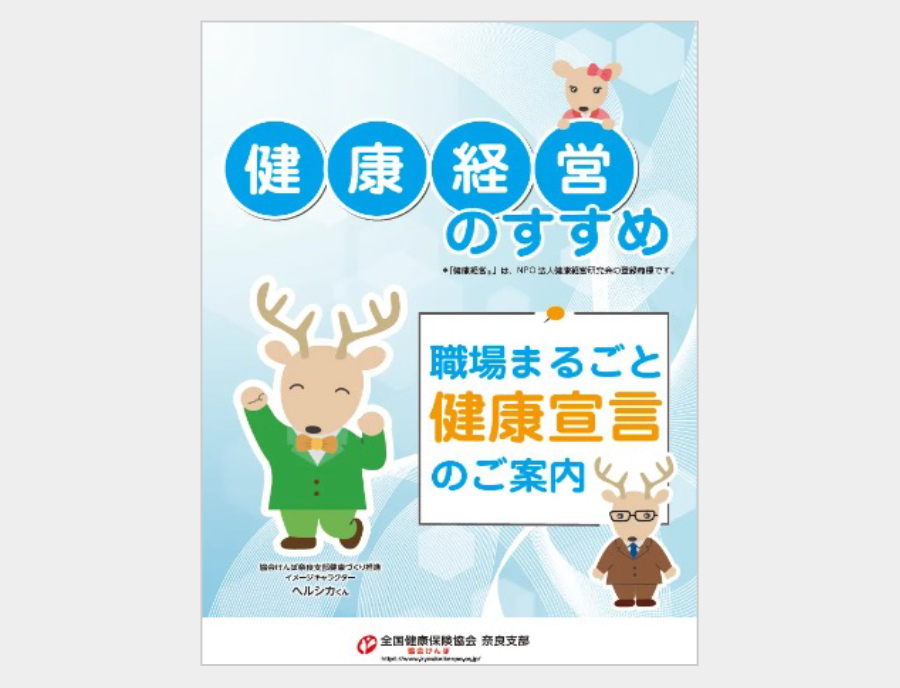
Target Values Focusing on Employee Lifestyle Habits (Fiscal Year 2025 Targets)
| Actual Values (Fiscal Year 2021) |
Target Values (Fiscal Year 2025) |
|
|---|---|---|
| 1. Percentage of People Interested in Lifestyle Improvement | 74.0% | 85.0% |
| 2. Rate of Good Walking Habits (Percentage of people engaging in physical activity like walking for at least one hour per day) |
40.0% | 50.0% |
| 3. Rate of Proper Dietary Habits (Percentage of people having meals within two hours before bedtime less than twice a week) |
63.7% | 70.0% |
Monitoring Indicators for a Healthy Body
| Health-related indicators | 2021年 | 2022年 | 2023年 |
|---|---|---|---|
| Percentage receiving regular health checkups | 100.0% | 100.0% | 100.0% |
| Percentage receiving specific health guidance | 21.8% | 20.2% | 27.5% |
| Percentage receiving full medical checkups | 59.6% | 60.9% | 57.1% |
| Not including those with metabolic syndrome★ | 74.5% | 74.1% | 71.5% |
| Rate of lipid risk★ | 58.3% | 53.8% | 53.3% |
| Rate of BMI risk | 28.9% | 29.1% | 30.4% |
| Rate of Poor blood pressure control | 2.3% | 3.0% | 2.9% |
| Rate of smoking risk | 25.8% | 27.0% | 25.7% |
| Rate of risk due to exercise habits | 74.9% | 76.9% | 75.9% |
| Rate of risk for sleep issues | 50.9% | 51.1% | 50.9% |
| Health management awareness | 96.4% | 93.9% | 95.0% |
| Workplace health challenge participation rate | 36.7% | 42.6% | 57.0% |
| Workplace health challenge satisfaction | 81.8% | 89.2% | 87.4% |
| Walking events participation rate | 15.3% | 15.1% | 16.9% |
| E-learning participation rate (Women’s Health Issues) | - | 85.0% | 79.6% |
★:Ultimate Outcome Indicators of Health Management
Healthy Body Initiatives
- Workplace Health Declaration (Hosted by the Japan Health Insurance Association Nara Branch)
- NITTA☆ Walking Festival
- Serving nutritious cafeteria meals planned by Kagawa Nutrition University
- Maintenance of Medical Office
In 2022, we established a medical room at the Nabari Plant, enhancing our industrial health system and strengthening collaboration with experts. - Anti-Smoking Measures
In addition to the medical office’s smoking cessation clinic, we provide subsidies for smoking cessation treatment at external medical institutions. In this way, we help employees quit smoking even in areas without a medical office.
Regarding a Healthy Mind
After analyzing the responses from stress checks and health examination questionnaires, we found that those with high stress levels have lower productivity due to presenteeism. Therefore, we set a goal of reducing the rate of high-stress individuals and conducted training and e-learning related to mental health to promote a positive mindset among employees.
As a result, despite the influence of changes in work patterns due to the COVID-19 pandemic, the rate of individuals with high stress levels fell from 19.9% in fiscal year 2019 to 18.5% by the end of fiscal year 2021.
Although the rate of high-stress individuals has been falling, we’re striving for a further reduction in this rate and a reduction of presenteeism, while promoting a positive mindset among employees.
As well as improving mental health awareness through training and e-learning, we will also take steps to prevent harassment by putting our managers through training and e-learning. This will promote good communication between managers and their staff.
Impact of High Stress on Presenteeism
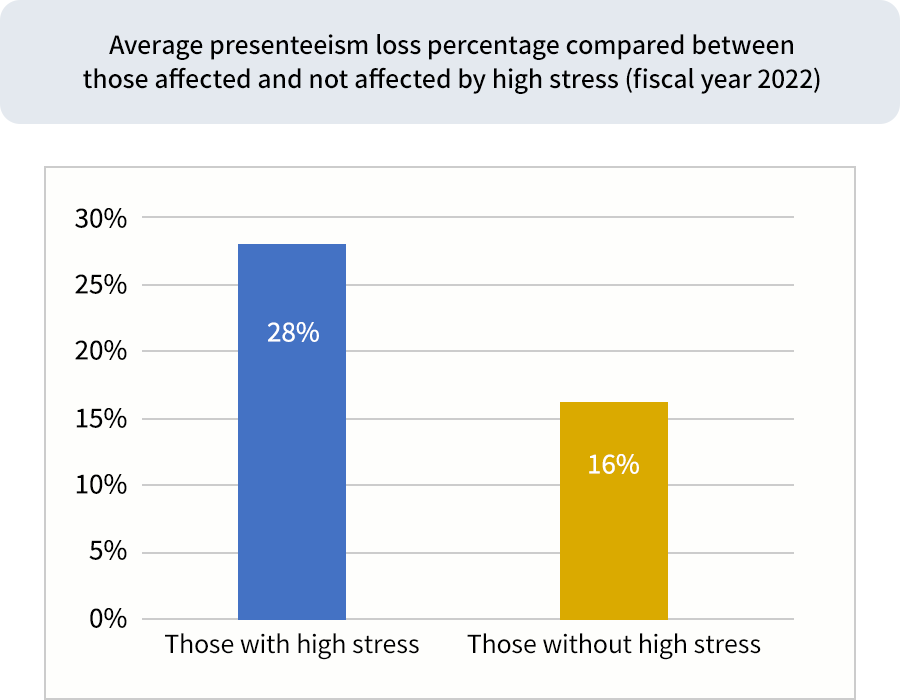
Mental Health Training for New Managers
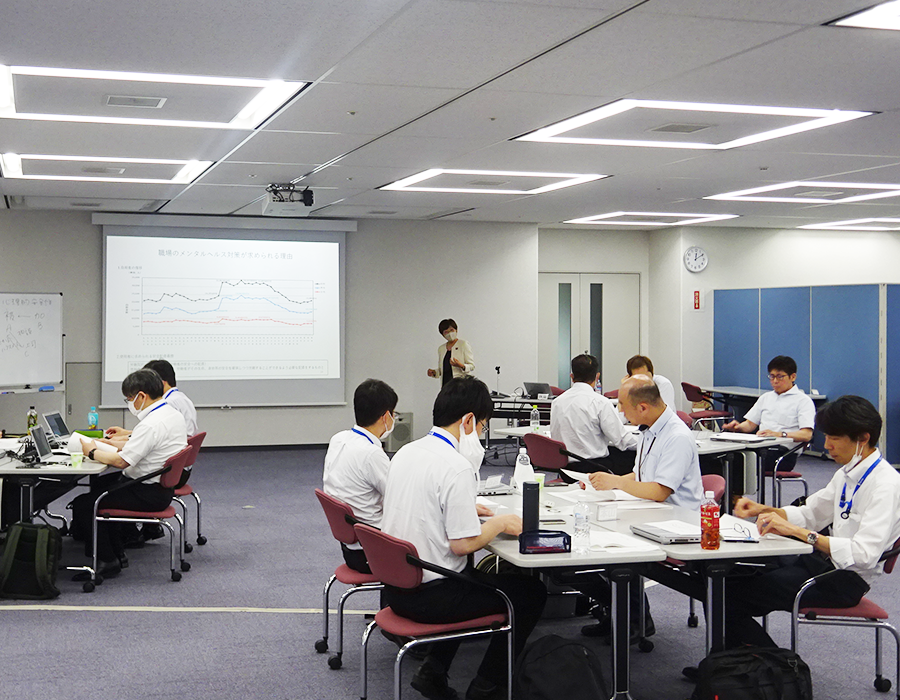
Monitoring indicators for a healthy mind
| Health-related indicators | 2021 | 2022 | 2023 | |
|---|---|---|---|---|
| Presenteeism ★ (*1,4) | 75.4% | 71.4% | 71.1% | |
| Stress check related | Stress check rate | 93.1% | 93.2% | 94.3% |
| High-stress employee percentage | 18.5% | 18.1% | 14.9% | |
| Leave-of-absence rate(*2) | 1.1% | 1.5% | 1.7% | |
| Absenteeism(*3,4) | 88.5% | 78.9% | 79.6% | |
★:Ultimate Outcome Indicators of Health Management
- Presenteeism: This refers to a condition where employees attend work but cannot perform at their full capacity due to health issues.
Self-assessment of one’s job performance when in perfect health is rated as 100%. This assessment evaluates one’s job performance in comparison to 100% when they are not sick or injured.
We ran a survey including a stress and productivity questionnaire (SPQ). The percentage of presenteeism loss ranged from 0% to 20%. - Percentage of employees on leave of absence for more than one month.
- In an employee survey, the percentage of people who answered “0–5 days” when asked about the number of days they missed work due to illness or injury in a year.
- Number of subjects of 2023: 994, Response rate: 93.1%.
Efforts Related to a Healthy Mind
- Mental health management education, E-learning on mental health
- Harassment training, E-learning on harassment
- Support for Employees with High Workloads
For employees with long working hours and high workloads, we have established a system providing consultation and support.
About a Healthy Workplace
To enhance the work-life balance of our employees and cultivate a vibrant workplace, the Nitta Group has been encouraging employees to take paid leave. Even so, there is some variation in the utilization rate across departments and job roles within the company. To help create a more vibrant workplace for a greater number of employees, we are aiming for a paid leave utilization rate of 75%.
By establishing an environment that encourages and tracks leave acquisition through the Human Resources department, and by streamlining operations in both field and support departments, we successfully increased leave utilization. In fiscal year 2022, the utilization rate of paid leave was 76.2%, meeting our target.
To continue achieving our targeted rate of paid leave utilization, we will keep streamlining operations and encouraging employees to use their paid leave. Also, under the leadership of the Human Resources Group, we will explore new initiatives to increase engagement with work, while continuing to promote a vibrant workplace.
Trend in Paid Leave Utilization Rate
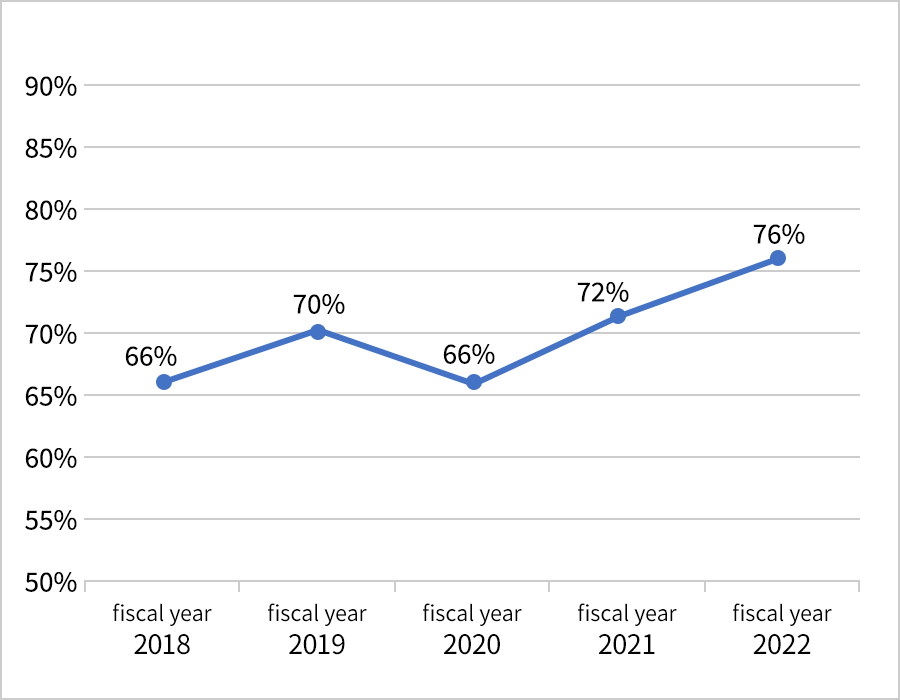
Scene from a QC Circle (voluntary quality control activities) presentation
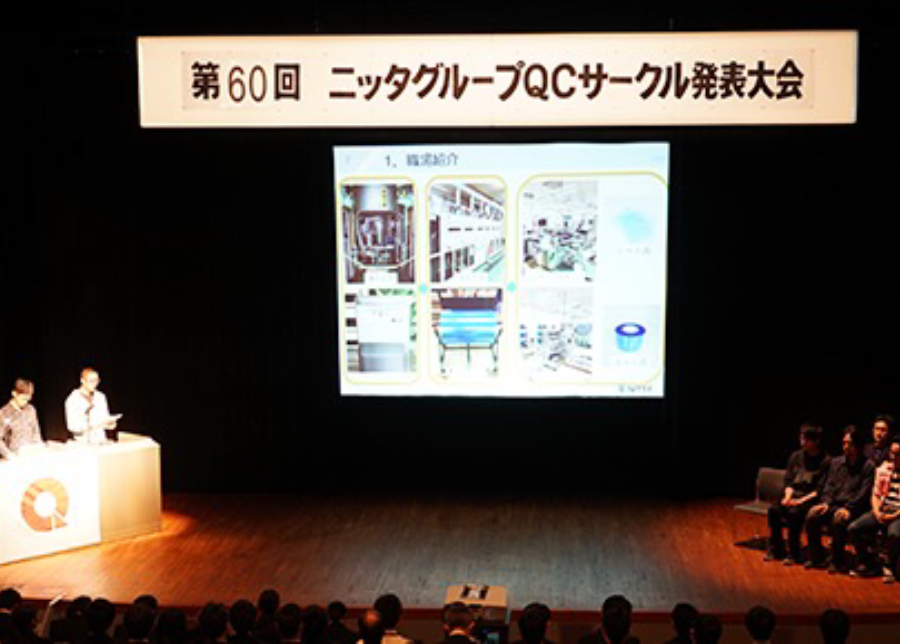
Monitoring Indicators for a Healthy Workplace
| Health-related indicators | 2020 | 2021 | 2022 | |
|---|---|---|---|---|
| Work Engagement ★ (*1) | 2.95点 | 2.9点 | 2.8点 | |
| Work-life balance | Average monthly overtime hours | 13.3H | 17.0H | 15.0H |
| Parental Leave Take-Up Rate (Female/Male) | Refer to the link | |||
| Percentage of employees taking paid leave | 65.2% | 71.5% | 76.2% | |
| Turnover Rate | 3.0% | 2.7% | 2.4% | |
★:Ultimate Outcome Indicators of Health Management
- Incorporate questions related to employee surveys, measure them using company-specific indicators, and calculate the average score (out of 4 points).
- Number of respondents: 1,023 people, Response rate: 89.2%.
Efforts to Promote a Healthy Workplace
- Promotion of Taking Paid Leave
- Support for Activities in Hobby Clubs
We support various hobby clubs, including baseball and tennis, and regularly mention them in our company newsletter to encourage employee participation.
(Currently there are 234 members, subsidized at around 5,000 yen per person)
Recognition of status and participation in projects, etc.
Certified as an “Excellent Health Management Company (White 500).”
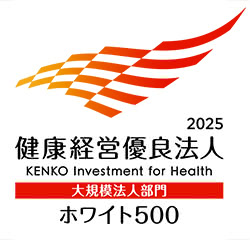
Our efforts in addressing employee health-related challenges have been recognized, and we were selected as a Health Management Brand in 2023 and 2024.
Additionally, for seven consecutive years since 2019, we have also been certified as a 2025 Health Management Excellent Corporation, Large Corporation Category (White 500).
What are health management issues?
The Ministry of Economy, Trade, and Industry, in collaboration with the Tokyo Stock Exchange, primarily selects one company per industry from the top 500 listed companies among the applicants for the Health Management Excellent Corporation (Large Corporation Category).
What is an Excellent Health Management Corporation?
The Ministry of Economy, Trade and Industry (METI) and the Japan Health Council jointly recognize corporations that practice excellent health management. In principle, the top 500 large corporations certified as excellent health management corporations are recognized as White 500 corporations.
Nitta has been recognized
as a 2025 Sports Yell Company

Nitta has been recognized as a 2025 Sports Yell Company* by the Japan Sports Agency.
Following last year, Nitta also has been awarded the Bronze Certification.
Nitta also has been awarded the Bronze Certification.
*Bronze Certification: This is granted to companies that have been recognized at least 5 times in total.
Certified years: 2020, 2021, 2022, 2023, 2024, 2025
*The Japan Sports Agency certifies companies that promote sports among prime working-age employees and are actively engaged in sports for the sake of employee health as Sports Yell Companies.
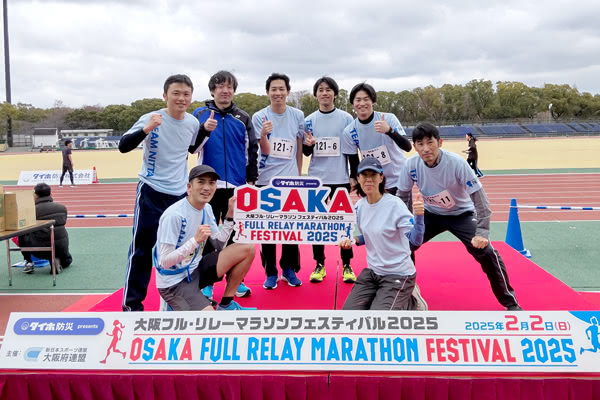
Activities of the Nitta Marathon Club
Member of the Sports in Life Project
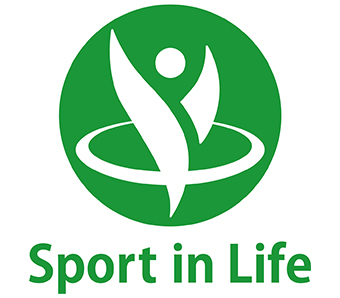
Nitta is a member of the Sports in Life* Consortium promoted by the Japan Sports Agency.
*Sport in Life website ⇒ https://sportinlife.go.jp/
Participating in the Fun+Walk Project

Nitta supports the Fun+Walk Project*, a public–private program operated in conjunction with the Japan Sports Agency.
We host regular walking events that provide fun and health-promoting opportunities for employees and their families to enjoy walking together.
Fun+Walk Project website ⇒ https://www.mext.go.jp/sports/funpluswalk/